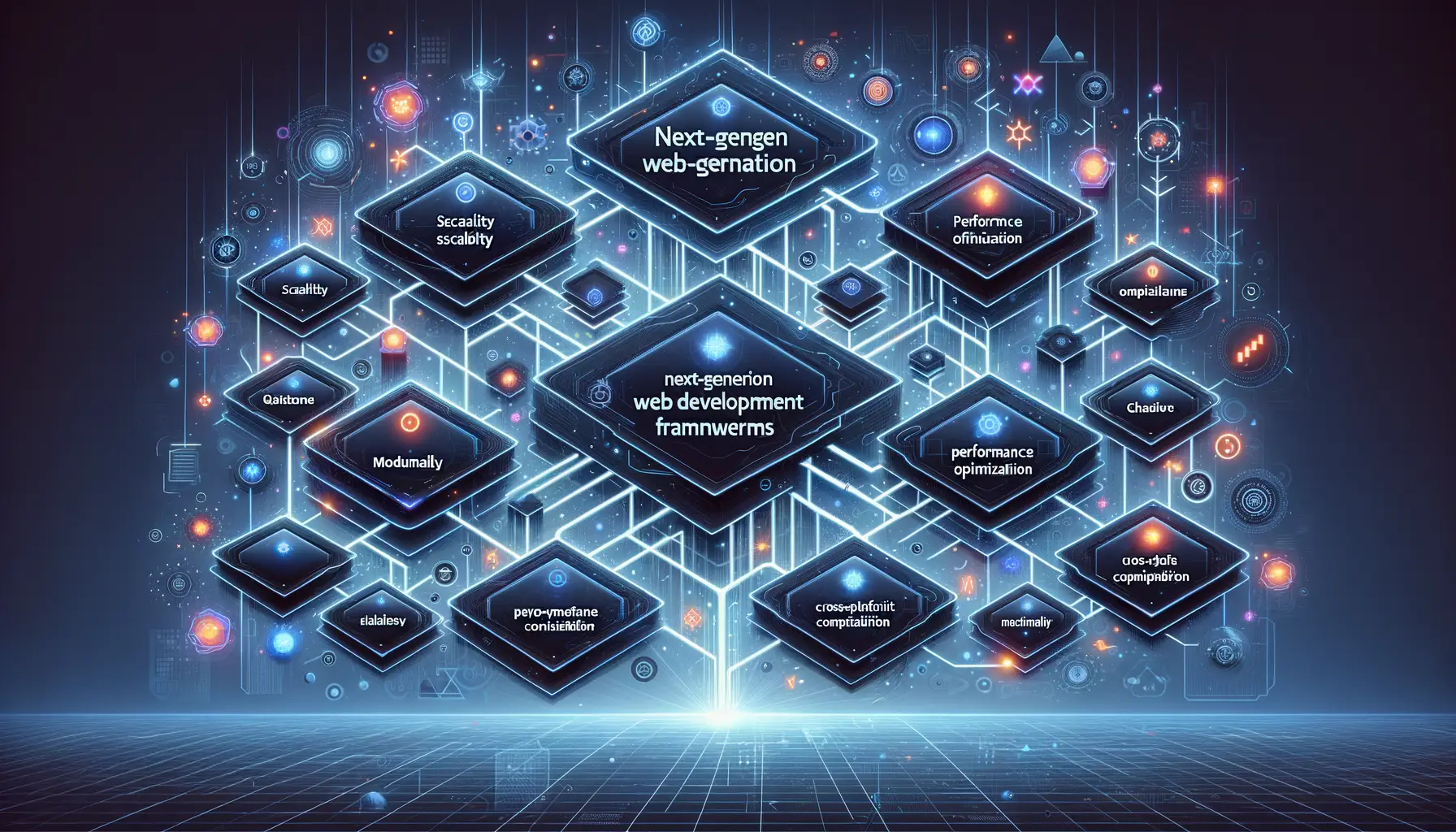Introduction to Open-Source Frameworks for Web Development
The digital world is like a bustling city that never sleeps, and at the heart of it all are open-source frameworks, the unsung architects behind stunning websites and smooth user experiences. But let’s face it – navigating the vast sea of options can feel overwhelming. Angular, React, Vue – where do you even begin?
Why Open-Source Frameworks Are a Game-Changer
Imagine building a house with a toolbox handed down from experts across the globe, each tool meticulously refined, free of charge. That’s what open-source web development frameworks offer – a collaborative ecosystem where innovation knows no bounds. Whether you’re crafting a sleek e-commerce platform or developing an interactive social app, these frameworks act as your sturdy foundation. And the best part? You’re not alone on this journey.
- Collaboration at its core: Developers worldwide contribute, improving functionality and fixing bugs faster than you’d believe.
- Cost-effective: No licensing fees, just pure potential for creativity and growth.
- Flexibility: Adapt the code to fit your vision; it’s like tailoring a suit to perfection.
With open-source frameworks, you’re not just coding – you’re joining a global conversation, one that drives the future of the web. How exciting is that?
Key Features of Next-Generation Web Development Frameworks

Revolutionary Efficiency and Developer-Centric Features
Next-generation web development frameworks aren’t just tools; they’re like a well-tuned sports car, built to make every click feel seamless. At their core, these frameworks are designed for speed and scalability. Imagine deploying a blazing-fast app that handles thousands of users without breaking a sweat. That’s the level they operate at.
One standout feature? Component-based architectures. Developers can now build modular components, like assembling a LEGO masterpiece, and reuse them across an application. This not only saves time but keeps your codebase clean and easy to maintain.
And let’s talk about developer experience. These frameworks live to spoil us with:
- Hot Module Replacement (HMR): No more page refreshes—see your changes instantly!
- TypeScript support: Type-safe coding without the headaches.
- Built-in testing tools: Because debugging shouldn’t be a chore.
Seamless Integration and Cutting-Edge Tech
The magic doesn’t stop there. Today’s frameworks are making friends with every library and tool out there. Think GraphQL APIs for real-time data fetching or integrating AI-driven features effortlessly. They bridge worlds, enabling you to combine legacy systems with futuristic capabilities.
Oh, and did we mention server-side rendering (SSR)? It’s like giving your website rocket fuel for SEO and performance. With SSR baked in, your pages load faster, rank higher, and keep visitors hooked.
Popular Open-Source Frameworks and Their Use Cases

Frameworks That Are Driving Innovation
Did you know some open-source frameworks are like secret recipes for your favorite meal? You don’t see all the ingredients, but you absolutely experience the magic they create. Let’s explore a few of these game-changers and their perfect pairings in web development.
React, crafted by Facebook, doesn’t just build websites—it builds experiences. Need a lightning-fast single-page application (SPA)? React’s got you covered. Think of platforms like Instagram or Airbnb; their seamless interfaces owe much to this powerhouse framework.
For developers chasing simplicity without compromising performance, there’s Vue.js. It’s like the Swiss Army knife of frameworks: flexible, lightweight, and perfect for interactive dashboards or dynamic e-commerce websites. Oh, and it’s beginner-friendly too—bonus points for that!
Django, on the other hand, is Python’s answer to “doing more with less.” Picture it as your go-to tool for creating secure, robust web apps. From handling backend logic to scaling for millions of users, Django simply delivers. Spotify and Pinterest seem to think so too.
When to Choose Which Framework?
Here’s where the magic of tailored choices happens:
- Got real-time interactions like chat apps? Go for Node.js.
- Building a portfolio or blog? Gatsby’s static site generation will impress.
- Think full-stack efficiency? Turn to Ruby on Rails.
So, which framework will you call your partner-in-code?
Benefits and Challenges of Using Open-Source Frameworks

The Bright Side: Why Open-Source Frameworks Shine
Open-source frameworks are like a treasure trove for developers, brimming with untapped potential and endless possibilities. One of their standout perks? They’re usually free. That’s right—no hefty licensing fees draining your project budget. Plus, these frameworks are built by communities of passionate developers who constantly refine and expand them. In other words? You’re not just using code—you’re tapping into a living, breathing ecosystem of innovation.
Another game-changer is the sheer flexibility. Need to tweak something to fit your vision? Open-source frameworks say, “Go ahead!” Whether you’re crafting a sleek portfolio or a robust e-commerce platform, you’ve got the freedom to customize. And let’s not forget that vast ocean of plugins, tools, and documentation designed to make your life easier, faster, and more creative.
- Cost-effective: Free access means more room in the budget for coffee or server upgrades.
- Collaborative power: Thousands of brains working together = better code quality.
- Endless adaptability: Mold it, shape it—make it yours!
The Hurdles: What Could Trip You Up
But let’s not sugarcoat it—open-source frameworks aren’t all rainbows and butterflies. First off, there’s the infamous issue of compatibility. Picture this: you’ve poured weeks into a project only to discover your favorite plugin isn’t playing nice with the latest framework update. Frustrating, right?
Then there’s the support—or lack thereof. Unlike paid software with dedicated customer service, you might find yourself digging through forums at 2 a.m., searching for answers. Oh, and security? While communities work hard, open-source frameworks can sometimes be a hacker’s playground if not regularly updated.
Still, armed with awareness and diligence, these frameworks can be a developer’s best friend. Just make sure you know what you’re diving into before taking the plunge!
Future Trends in Open-Source Web Development

Riding the Wave of AI and Automation
The future of open-source web development feels like standing on the edge of a thrilling roller coaster. One of the biggest drivers shaping this landscape is the integration of AI-powered tools and automation. Imagine frameworks that don’t just assist developers but actively collaborate with them—writing code snippets, detecting bugs in real time, and even suggesting design tweaks based on user behavior data. Tools like GitHub Copilot are merely scratching the surface of what’s possible.
Think about this: what if your framework could predict trends in user interactions or generate custom components tailored to specific audiences? That’s where we’re headed. The marriage of machine learning with open-source is transforming “good enough” into “exceptional.”
- AI-driven testing: Faster bug fixes and smarter debugging processes.
- Automated optimization: Real-time improvements for performance and security.
The Rise of Micro Everything
In the world of open-source, size matters—but not the way you think. Say goodbye to bulky, monolithic architectures. The future belongs to micro-frontends, microservices, and modular design principles. Developers are moving toward creating smaller, independent pieces that fit together like LEGO blocks, offering unparalleled flexibility.
Picture this: an e-commerce site where the cart, checkout, and search functions all operate independently, yet seamlessly. It means faster upgrades, independent scaling, and fewer headaches when something needs fixing. Open-source frameworks like Vue.js and Kubernetes are paving the way for this shift toward lightweight, highly adaptable structures.
Tomorrow’s open-source web development isn’t just about keeping up—it’s about staying ahead.












